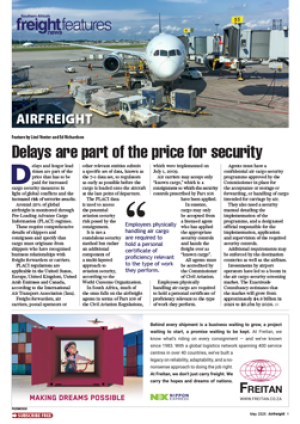On Africa’s east coast the port
of Djibouti has embraced
privatisation, with DP World
taking over the operation of the port
and establishing a successful regional
container hub.
Further south the port of Mombasa
in Kenya, which is one of those that
turned its back on privatisation, has
embarked on a programme of dredging
and a Japanese loan of US$200 million
has secured the construction of a second
container terminal.
Mombasa has endured periods
of chronic congestion, worsened by
political upheaval that disrupted the
movement of cargo from the port to
neighbouring Uganda.
Mombasa’s second container terminal
is expected to be completed by 2013
and will have capacity for 1.2 million
TEUs. The existing terminal handled
615 000 TEUs and the port a total of
16.5mt of cargo during 2008.
Tanzania’s principal port of Dar es
Salaam recently cancelled an exclusivity
concession clause with container
terminal operator Tanzania International
Container Services (TICTS). The new
agreement enables Tanzania to bring
in other terminal operators or revert to
running the remainder of the port as a
state-owned entity once again and stems
from widespread dissatisfaction over the
progress of privatisation at the port.
Uganda, Kenya and Tanzania’s
flirtation with rail privatisation quickly
hit rocky ground with indications that
Kenya and Uganda clearly wanted
the rail concession held by Rift Valley
Railway cancelled, while in Tanzania
the concessionaire Rites of India has
been forced to defend its performance
despite being less than two years in
operation and having inherited a broken,
rundown railway operation.
In Mozambique the ports of Maputo
and Nacala experienced similar pressure
from government and other national
bodies amidst an underlying opposition
to the principle of state-owned
corporations being left in the hands of
foreign operators.
The American concession holder for
the Nacala railway and port company,
itself under stress, sold out to local
interests, while in Maputo the Britishcontrolled
operator of Maputo Port
Development Company, also under
pressure from government, sold out
to South Africa’s Grindrod Group.
Grindrod subsequently entered into an
operating agreement with international
terminal operator DP World.
Only at the port of Beira, operated
by Dutch-controlled Cornelder, does it
seem that there has been an acceptance
of private operation although not a
great amount of progress is apparent
with regard to increasing the capacity
and performance of the port. With
the refurbishment of the former Sena
railway and the advent of large-scale
coal exports from the Moatize district
through the port of Beira from 2010,
efforts are now turning to dredging the
port to more acceptable levels.
In Namibia Walvis Bay continues
to be a success story with improved
efficiencies and a huge step forward in
ship repair, although efforts to attract
increased shipping and meaningful
volumes of trade along the respective
transport corridors into Botswana, South
Africa, Zimbabwe, Zambia and the
DRC have been marginally successful –
but it’s still early days.
Angola’s ports remain problematic
Angola’s ports remain hugely
problematic in terms of delays and
congestion. Of the country’s four main
ports – Luanda, Lobito, Namibe and
Malongo – Luanda has been described
as one of the world’s most congested
ports, despite in excess of
US$100 million being spent on
upgrades aimed at reducing delays.
Angola’s northern neighbour the
DRC is unique in that despite having
over 9 000km of common border, it has
a mere 40km of coastline. Matadi is the
country’s principal port. Although fairly
well equipped, the port has a restrictive
draught of 6.4m.
The Congo’s (Brazzaville) main port
is Pointe Noire, approximately 150km
north of the Congo River, and is served
by an operating railway into the interior.
This is one of the few deepwater ports
in West Africa with a draught up to
13.2m and is also one of the better
equipped ports with nearly 5km of
quayside. About three million tonnes of
cargo is worked annually. Construction
is due to commence early in 2010 on a
new container terminal which will be
managed by the French Bolloré Group
on a 27-year concession.
Douala in Cameroon is central
Africa’s busiest port. The port is
connected to the capital Yaoundé by
rail and road. Interconnecting highways
linking Cameroon, Congo, DRC,
Gabon, Equatorial Guinea and Central
African Republic are planned in an
effort to strengthen regional integration
in central Africa.
Regional port system – is privatisation the answer?
25 Nov 2009 - by Staff reporter
0 Comments
Africa Outlook 2009

25 Nov 2009
25 Nov 2009
25 Nov 2009
25 Nov 2009
25 Nov 2009
25 Nov 2009
25 Nov 2009
